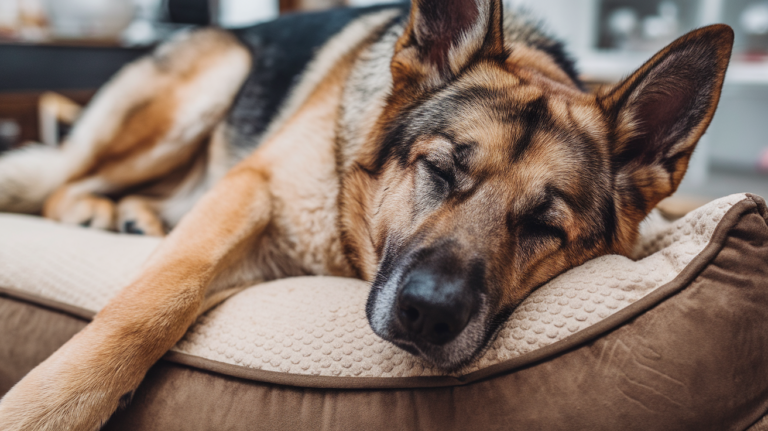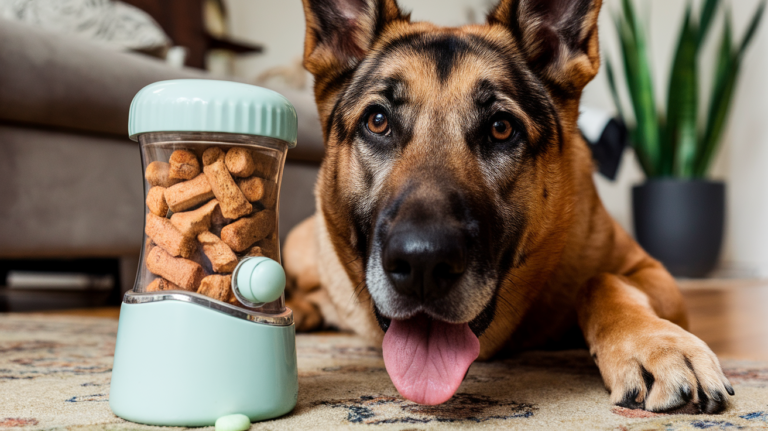German Shepherds are renowned for their loyalty, intelligence, and protective instincts. These majestic dogs have been bred for centuries to serve as working dogs, particularly in roles that involve guarding and protecting.
As family pets, they often transfer these innate behaviors to their human companions, creating a strong bond and a sense of security in the household.
This article explores nine distinct ways that German Shepherds demonstrate their protective nature, showcasing how these remarkable canines go above and beyond to ensure the safety and well-being of their human families.
1. Blocking Your Path
Your German Shepherd might literally place themselves between you and a perceived danger, such as an oncoming dog or a suspicious individual. This blocking behavior is their way of creating a barrier to shield you from harm. By positioning themselves in front of you, they take on the role of a physical barrier to protect you from perceived threats.
This instinctive action demonstrates the German Shepherd’s commitment to your safety. They assess the situation quickly and react by using their body as a shield. This behavior is particularly noticeable when you’re out for walks or in public spaces where unexpected encounters may occur.
Your dog’s swift positioning not only provides immediate protection but also serves as a visual deterrent to potential aggressors, human or animal. This protective stance is often accompanied by alert body language, such as raised ears and an intense gaze, further emphasizing their readiness to defend you if necessary.
2. Barking at Unusual Sounds
German Shepherds have acute hearing and can pick up on sounds that humans typically miss. If you notice your dog barking at sounds like footsteps, doorbells, or even noises outside at night, they may be alerting you to potential danger. Their barking serves as an alarm system, ensuring you are aware of unusual activity around your home.
This auditory vigilance is a crucial aspect of a German Shepherd’s protective repertoire. Their ability to detect and differentiate between normal environmental sounds and potential threats is remarkably refined.
When they bark at unusual noises, they’re not just making noise; they’re communicating valuable information to you. The tone and intensity of their barks can vary depending on the perceived level of threat, ranging from a low “woof” for mild concern to sharp, repetitive barks for more serious alerts.
This behavior allows you to investigate potential issues or take necessary precautions, even when you might not have noticed anything amiss on your own.
3. Standing Guard at the Door
If your German Shepherd frequently positions themselves near the front door or windows, they might be safeguarding the entry points of your home. By keeping a vigilant watch over these areas, they are ready to alert you to any unusual activity or intruders, thus maintaining a protective perimeter around your living space.
This behavior stems from the German Shepherd’s natural inclination to establish and defend territory. By stationing themselves at key entry points, they create a first line of defense against potential intruders.
This guarding behavior is often accompanied by attentive body language, such as perked ears and an alert posture. Your dog may alternate between sitting or standing, but their focus remains on monitoring the area for any signs of unusual activity.
This constant vigilance not only provides an early warning system but also acts as a visual deterrent to anyone considering unauthorized entry into your home.
4. Following You Room to Room
German Shepherds are known for their loyalty and strong attachment to their owners. When your dog follows you from room to room, they are not just seeking your company; they are also making sure you are safe. This constant companionship is a subtle form of protection, as they stay close by to respond quickly to any threats.
This behavior, often referred to as “velcro dog” syndrome, is a hallmark of the German Shepherd’s protective nature. By maintaining close proximity, they ensure that they can react swiftly to any potential danger that might arise.
This constant presence allows them to monitor your well-being and the surrounding environment continuously. It’s not uncommon for a German Shepherd to position themselves strategically in each room, often choosing spots that allow them to observe both you and potential entry points.
This behavior also strengthens the bond between you and your dog, as it reinforces their role as your dedicated protector.
5. Intense Staring
Sometimes, your German Shepherd might fixate their gaze on a person or situation with intense focus. This staring behavior is often a sign that they are assessing a potential threat. By scrutinizing the situation, they gather information and prepare themselves to act if necessary, showing their readiness to protect you.
This intense staring is a clear demonstration of the German Shepherd’s heightened awareness and protective instincts. When they engage in this behavior, they’re not just looking; they’re actively processing and evaluating the situation for any signs of danger.
Their fixed gaze allows them to detect even the slightest changes in body language or movement that might indicate a threat. This behavior is often accompanied by other subtle signs of alertness, such as slightly raised hackles or a stiffened body posture.
By maintaining this focused observation, your German Shepherd is essentially conducting a continuous risk assessment, ready to spring into action if they determine that intervention is necessary to ensure your safety.
6. Aggressive Posturing
When a German Shepherd senses danger, they might adopt an aggressive posture — ears pinned back, tail raised, and body stiffened — to intimidate the perceived threat. This posturing is a clear signal to any potential aggressor that they should stay away, adding a level of deterrence that helps to keep you safe.
This display of aggressive body language is a powerful communication tool in your German Shepherd’s protective arsenal. By adopting this posture, they make themselves appear larger and more intimidating, often accompanied by low growls or showing of teeth.
This behavior serves multiple purposes: it warns the potential threat to back off, it prepares your dog physically for possible confrontation, and it alerts you to the presence of danger.
The aggressive posture is typically a last resort before physical intervention, giving the perceived threat a clear opportunity to retreat. It’s important to note that while this behavior is protective, it should be monitored and properly managed to ensure it doesn’t escalate unnecessarily.
7. Nighttime Vigilance
Your German Shepherd’s protective instincts don’t sleep when you do. Many Shepherds patrol the house at night, checking doors, windows, and unusual sounds. This vigilance ensures that any nocturnal threats are promptly detected and addressed, providing an added layer of security while you rest.
This nighttime patrolling behavior is a testament to the German Shepherd’s unwavering commitment to protecting their family. As naturally crepuscular animals (most active during twilight hours), they are well-suited for nighttime vigilance.
During these patrols, your dog may make rounds of the house, checking each room and paying special attention to entry points. They might pause to listen intently at windows or doors, using their acute hearing to detect any unusual sounds outside.
If they hear something suspicious, they may alert you with a bark or by coming to your bedside. This nocturnal watchfulness provides an invaluable security service, allowing you to sleep peacefully knowing that your loyal guardian is on duty.
8. Herding Family Members
Bred for herding, German Shepherds sometimes extend this behavior to the family. By gently nudging or guiding family members, especially children, they ensure everyone stays together and safe. This herding behavior can help to prevent anyone from wandering into potentially dangerous situations.
This herding instinct, when applied to family members, is a unique way that German Shepherds express their protective nature. You might notice your dog circling around family members during walks or in open spaces, gently bumping or nudging those who stray too far from the group.
This behavior is particularly evident with children, whom the dog may perceive as more vulnerable. By keeping the family unit close together, your German Shepherd reduces the risk of individuals becoming separated or exposed to potential dangers.
This herding behavior also allows your dog to maintain a better overview of everyone’s safety, ensuring that all family members remain within their protective sphere of influence.
9. Licking and Nuzzling
Though it might seem purely affectionate, licking and nuzzling can also be protective behaviors. These actions can serve to calm and reassure their humans, reducing stress and promoting a sense of safety. It’s their way of saying “I am here, and I am looking out for you.”
While these gentle behaviors might not seem as overtly protective as some of the others, they play a crucial role in your German Shepherd’s overall protective strategy.
Licking and nuzzling are forms of social bonding that strengthen the connection between you and your dog. This strong bond is fundamental to their desire to protect you.
Additionally, these behaviors serve as a form of health check; through close contact, your dog can pick up on subtle changes in your scent or demeanor that might indicate illness or distress.
By engaging in these affectionate behaviors, your German Shepherd is not only expressing love but also reassuring themselves of your well-being and reinforcing their role as your protector. This emotional support is an often-overlooked aspect of protection that contributes significantly to your overall sense of security and comfort.






